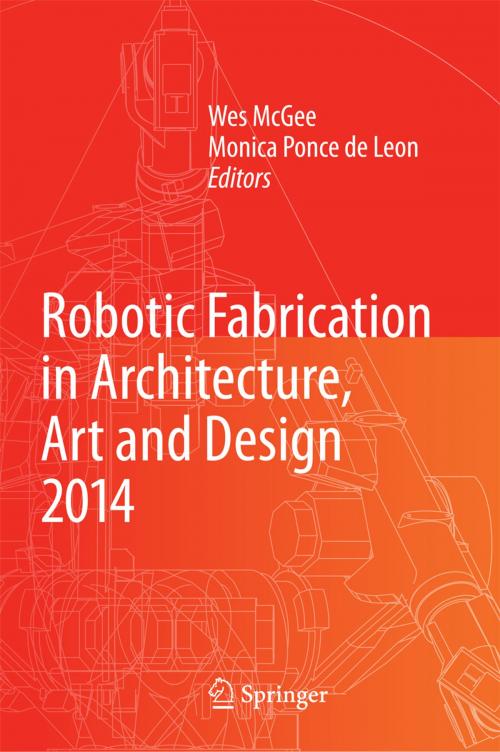Robotic Fabrication in Architecture, Art and Design 2014
Nonfiction, Computers, Advanced Computing, Programming, User Interfaces, Science & Nature, Technology, Robotics| Author: | Aaron Willette | ISBN: | 9783319046631 |
| Publisher: | Springer International Publishing | Publication: | March 20, 2014 |
| Imprint: | Springer | Language: | English |
| Author: | Aaron Willette |
| ISBN: | 9783319046631 |
| Publisher: | Springer International Publishing |
| Publication: | March 20, 2014 |
| Imprint: | Springer |
| Language: | English |
Robotic automation has become ubiquitous in the modern manufacturing landscape, spanning an overwhelming range of processes and applications-- from small scale force-controlled grinding operations for orthopedic joints to large scale composite manufacturing of aircraft fuselages. Smart factories, seamlessly linked via industrial networks and sensing, have revolutionized mass production, allowing for intelligent, adaptive manufacturing processes across a broad spectrum of industries. Against this background, an emerging group of researchers, designers, and fabricators have begun to apply robotic technology in the pursuit of architecture, art, and design, implementing them in a range of processes and scales. Coupled with computational design tools the technology is no longer relegated to the repetitive production of the assembly line, and is instead being employed for the mass-customization of non-standard components. This radical shift in protocol has been enabled by the development of new design to production workflows and the recognition of robotic manipulators as “multi-functional” fabrication platforms, capable of being reconfigured to suit the specific needs of a process.
The emerging discourse surrounding robotic fabrication seeks to question the existing norms of manufacturing and has far reaching implications for the future of how architects, artists, and designers engage with materialization processes. This book presents the proceedings of Rob|Arch2014, the second international conference on robotic fabrication in architecture, art, and design. It includes a Foreword by Sigrid Brell-Cokcan and Johannes Braumann, Association for Robots in Architecture. The work contained traverses a wide range of contemporary topics, from methodologies for incorporating dynamic material feedback into existing fabrication processes, to novel interfaces for robotic programming, to new processes for large-scale automated construction. The latent argument behind this research is that the term ‘file-to-factory’ must not be a reductive celebration of expediency but instead a perpetual challenge to increase the quality of feedback between design, matter, and making.
Robotic automation has become ubiquitous in the modern manufacturing landscape, spanning an overwhelming range of processes and applications-- from small scale force-controlled grinding operations for orthopedic joints to large scale composite manufacturing of aircraft fuselages. Smart factories, seamlessly linked via industrial networks and sensing, have revolutionized mass production, allowing for intelligent, adaptive manufacturing processes across a broad spectrum of industries. Against this background, an emerging group of researchers, designers, and fabricators have begun to apply robotic technology in the pursuit of architecture, art, and design, implementing them in a range of processes and scales. Coupled with computational design tools the technology is no longer relegated to the repetitive production of the assembly line, and is instead being employed for the mass-customization of non-standard components. This radical shift in protocol has been enabled by the development of new design to production workflows and the recognition of robotic manipulators as “multi-functional” fabrication platforms, capable of being reconfigured to suit the specific needs of a process.
The emerging discourse surrounding robotic fabrication seeks to question the existing norms of manufacturing and has far reaching implications for the future of how architects, artists, and designers engage with materialization processes. This book presents the proceedings of Rob|Arch2014, the second international conference on robotic fabrication in architecture, art, and design. It includes a Foreword by Sigrid Brell-Cokcan and Johannes Braumann, Association for Robots in Architecture. The work contained traverses a wide range of contemporary topics, from methodologies for incorporating dynamic material feedback into existing fabrication processes, to novel interfaces for robotic programming, to new processes for large-scale automated construction. The latent argument behind this research is that the term ‘file-to-factory’ must not be a reductive celebration of expediency but instead a perpetual challenge to increase the quality of feedback between design, matter, and making.















